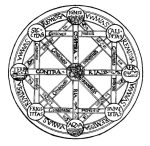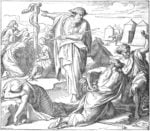The Ten Days of Nesira: A Mystical Journey of Separation and Union
By Alexander Poltorak לע”נ אבי מורי, אברהם שמשון ע”ה בן ראובן Between the jubilation of Rosh HaShanah and the solemnity of Yom Kippur lie ten
By Alexander Poltorak לע”נ אבי מורי, אברהם שמשון ע”ה בן ראובן Between the jubilation of Rosh HaShanah and the solemnity of Yom Kippur lie ten
I. Introduction Every year on Rosh HaShanah, the raw, unarticulated cry of the shofar cuts through silence. For Kabbalah, that cry is not mere ritual

Alexander Poltorak Abstract This essay addresses the anigmatic statement of the Jewish Sages, stating that G-d created this world with the letter Heh and the
… mi‑b’sari echezeh Elokah—From my flesh I behold G‑d (Job 19:26) Introduction – “In His Image” The Torah’s initial description of humanity is both profound and enigmatic:
By Alexander Poltorak Abstract The Torah portion of Shemini records the climactic eighth day of the Tabernacle’s dedication, the moment when divine fire finally descends.
By Alexander Poltorak Introduction The relationship between the laws of physics and the conditions necessary for life is among the most profound mysteries in both

By Alexander Poltorak And there I will meet with you, and I will speak with you from above the cover, from between the two cherubim
By Alexander Poltorak The Tree of Life and the Tree of Knowledge as Metaphors for the Wave Function and Measurement Summary This essay proposes a

The parallels we have uncovered between the four elements, the letters of the Tetragrammaton, and the worlds of Seder Hishtalshelut suggest that the ancient sages
And it came to pass, when he was come near to enter into Egypt, that he said unto Sarai his wife: “Behold now, I know
Abstract This essay explores the profound connections between language, philosophy, physics, and spirituality in the context of Rosh HaShanah. By examining the linguistic roots of
It’s All in the Name Rosh HaShanah is usually translated as the New Year. When translated literally, it means the “Head of the Year.” In

Introduction In this essay, I intend to draw a parallel between the singularity in space-time, such as the putative point of origin of the universe
Zealotry and Mercy: Parallels Between Pinchas and the War in Gaza The biblical story of Phinehas (Heb. Pinḥas or Pinchas) presents a complex moral scenario

The Temple Menorah served as a lighthouse, illuminating darkness and providing purpose and direction.

And on the eighth day, the flesh of his foreskin shall be circumcised. Leviticus 12:3 In the Torah portion of Tazria, we are commanded to

The Torah portion Tzav describes a ritual performed by Moses in consecrating Aaron as the High Priest (Kohen Gadol) and his sons as priests (kohanim):

The least action principle is an expression of teleological reasoning where the initial states of the system are determined by the endpoints—the beginning and the
A-Series and B-Series as Zman and Seder HaZmanim McTaggart’s series A and series B are two conceptual frameworks proposed by the philosopher J.M.E. McTaggart[1] to

And for the unclean they shall take of the ashes of the burning of the purification from sin, and running water shall be put thereto

Introduction What could the Standard Model of particle physics possibly have in common with biblical accounts of the Israelites’ travels in the Sinai Desert, Kabbalistic

Cartesian dualism, or mind-body dualism, formulated by the French scientist, mathematician, and philosopher René Descartes (1596–1650), holds that the body and the mind (which he
Structurally identical biblical accounts of creation, destruction, and restoration are viewed as a manifestation of dialectic triad thesis-antithesis-synthesis.

The history of Creation can be expressed in three words (not even words but mere conjunctions): “and,” “or,” and “and/or,” whereas the history of physics
In the proposed allegorical interpretation, the soldier in the war is a metaphor for the Jewish people, who are all “soldiers” in G‑d’s army Tzivot

The forty-nine days between Passover and Shavuot are called the days of Sefira or the days of counting Omer—Sefirat HaOmer—when Jews count every day as

This is the fourth installment in the series of essays on the nature of the soul. The first three installments can be found here: What

…[H]e who tries to cure the soul, wishing to improve the moral qualities, must have a knowledge of the soul in its totality and

In the biblical story of the creation of Adam, the Torah states: Then the Eternal G‑d formed man of the dust of the ground, and

Now the earth was unformed and void. Genesis 1:2 We have a big problem in cosmology: the problem of the initial conditions of the universe at

Now as I beheld the Chayot [living creatures], behold one Ophan [wheel] at the bottom hard by the living creatures, at the four faces thereof. The

The collapse of the wave function is the process of revealing hidden possibilities. Reducing uncertainty reveals information. Until the wave function collapse, the system is

And afterwards she bore a daughter, and called her name Dinah. (Genesis 30:21) In my previous essay, “The Conflict Between Joseph And His Brothers—A Gender

The confrontation between Joseph and his brothers is one of the most troubling stories of the Bible. Joseph and his brother—twelve sons of Jacob—were the

So the present passed over before him; and he himself lodged that night in the camp. And he rose up that night, and took his

Now Laban had two daughters: the name of the elder was Leah, and the name of the younger was Rachel. (Genesis 29:16) Rabbi Isaiah Horowitz (the

And these are the chronicles of Isaac… (Genesis 25:19) So Esau went unto Ishmael, and took unto the wives that he had Mahalath the daughter

And Rebekah spoke unto Jacob, her son, saying: “Behold, I heard thy father speak unto Esau thy brother, saying: Bring me venison, and make me

A light shalt thou make to the ark…with lower, second, and third stories shalt thou make it. (Genesis 6:16) We mentioned in the previous posts

A light shalt thou make to the ark, and to a cubit shalt thou finish it upward; and the door of the ark shalt thou

In the previous post “Physics of Tzimtzum I—The Quantum Leap”, we gave a general overview of the mystical doctrine of tzimtzum—the cornerstone of Lurianic Kabbalah.

Introduction “In the beginning G‑d created the heavens and the earth.” (Genesis 1:1) “In the beginning G‑d created the heavens and the earth,” the Torah

A Study in Form and Matter And Moses prayed for the people. And the Eternal said unto Moses: “Make thee a fiery serpent, and set it

For the life of the flesh is in the blood.” (Leviticus 17:11) The word translated here as “life” in the Hebrew original is nefesh, i.e.,

There is a Biblical Commandment to count the days between the Passover and Shavuot, the “Feast of Weeks” (a.k.a. Pentecost). We start counting on the

And every meal-offering of thine shalt thou season with salt; neither shalt thou suffer the salt of the covenant of thy G‑d to be lacking

The Torah portion Vayakhel deals with the construction of the Mishkan, i.e., the “Tabernacle.” In Kabbalah, the Mishkan is viewed as a microcosm that represents

On the Eve of Shabbat, we received a government mailing containing documents that we were required to fill out and send back to the Census

In the beginning G‑d created the heaven and the earth. (Genesis 1:1) The first verse in the Torah is key to understanding the fundamentals

And the Eternal G‑d said: “It is not good that the man should be alone; I will make him a helpmate opposite him.” (Genesis 2:18)

As we discussed in the earlier post, The Tree of Knowledge as a Metaphor for Superposition of States and Heisenberg’s Uncertainty Principle, the Heisenberg uncertainty

Strings vibrate, Souls tremble, Angels are running and returning, G‑d is touching and not touching – The rhythms of the universe… Nothing stays still… all

Then drew near the daughters of Zelophehad …. of the families of Manasseh, the son of Joseph; and these are the names of his daughters:

Meditations on the Maaseh Merkavah – IV This is the fourth and the final installment in the series of posts related to Ezekiel’s prophesy, Ma’aseh

Meditations on the Maaseh Merkavah – I We do science by studying nature. We study physics in a lab, peering into space or working out

And the life of Sarah was one hundred years and twenty years and seven years… (Gen. 23:1) Why did Esther merit to rule over 127

The months of Tishrei is full of holidays, and they all share a common theme—the unification of time—past, present, and future. It all starts with

And the Eternal spoke unto Moses, after the death of the two sons of Aaron, when they drew near before the Eternal and died. (Leviticus

And thou shalt make two cherubim of gold; of beaten work shalt thou make them, at the two ends of the ark-cover. And make one
Last week Torah portion, Emor, speaks about the prohibition of working on Shabbat. In fact, the Talmud enumerates precisely 39 categories of labor forbidden on

Balak the son of Zippor saw all that Israel had done to the Amorites. Moab became terrified of the people, for they were numerous, and

I grew up in Russia and was raised on the metric system based on decimal arithmetic. When we immigrated to the U.S., I had to

The mezuzah is one of the few miẓvot ([divine] “commandments”) for which the Torah states its reward. In this case, the reward is a long

These are the journeys of the children of Israel… (Numbers 33:1) When G-d brought the Jews out from Egypt, He brought them out with the mystery of
Bo: Exodus 10:1 – 14:16 The Erev Shabbat parshat Bo (the Eve of Sabbath of the week when we read the Torah section Bo) 2014

There is a continuous thread about the mastery of time that weaves through the last chapters of the book of Genesis (Bereshit) and continues through

Reading the Torah, sometimes, can give a false impression of reading a story, albeit the greatest story ever written. This Divine drama involves colorful characters,

Speak to the children of Israel and have them take for you a perfectly red unblemished cow, upon which no yoke was laid… The cow

The Hebrew words taharah and tumah, which are the subjects of the Torah portion of Chukat (Numbers 19:1–22:1), are usually translated as ritual purity and
Presented at the International Torah and Science Conference in Miami International University on December 18, 2005 Alexander Poltorak Introduction. This is the third in